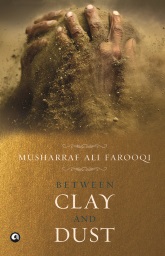Between Clay And Dust
Musharraf Ali Farooqi
|
|
Once upon a time, in the subcontinent, there existed a hierarchy of customs and cultures within which professions such as that of the pahalwan and the tawaif were patronised by the elite and governed by strict rituals, customs and codes. Musharraf Farooqi’s new novel Between Clay and Dust tells the tale of an aging, famed pahalwan, Ustad Ramzi, and an elderly and celebrated tawaif Gohar Jan. Both continue to live in the crumbling inner city of a nameless town which has seen great changes after Partition. The timeless etiquette and rules of a world known to them cannot cope with the confrontation with modernity. Farooqi’s spare, tightly honed prose and the quiet unfurling of the plot resembles the seamless movements of a dance, in which sudden implosions of violence and unexpected denouements are reflected by a change in the dancer’s steps but are contained within the fluidity of the whole. This sense of physicality and grace is enhanced by a narrative where much is suggested through gesture and nuance. At the same time, Farooqi’s eye for detail vividly brings to life the two main protagonists and their respective establishments. Both Ustad Ramzi and Gohar Jan belong to professions which exploit the human body, but the timeless disciplines and codes of honour provide an anchor which imbues their days with order, dignity and meaning. Ustad Ramzi’s craft glorifies the muscle power and strength of the male body, but he has made a vow of celibacy. On the other hand, Gohar Jan’s absolute dedication to her art as a singer and a musician, veils the sale of the female body that is implicit to life in the kotha. In traditional society, the onset of old age would have meant that Ustad Ramzi and Gohar Jan would continue to earn by training younger apprentices to follow the traditions of their respective establishments. But in the modern day, they have become but obsolete vestiges of a lost world. Ustad Ramzi, the head of a pahalwan clan, holds the title of Ustad-e-Zaman, which he had won 15 years earlier, in 1935, after defeating the defending champions – his clan’s long-time rivals. Daily, he begins the day by pounding clay in the wrestler’s akhara, of which he is a custodian. He is aware of the pain in his joints and other symptoms of deteriorating health. His brother Tamami, 20 years his junior, has no interest in the rituals his brother holds dear, nor offers to help. Tamami is also a reckless braggart. He taunts Imama, the champion of a rival clan, and challenges him to a match. Ustad Ramzi knows his brother is not ready for such a bout. He steps in to fight in Tamami’s stead. The preparations for the grand spectacle include plates of dried dates and pitchers of sardai “prepared with almonds, milk and herbs” for the spectators. Ustad Ramzi, dressed in a white turban and a coverlet “embroidered with Quranic verses,” is carried to the ground on the shoulders of the trainees, reciting auspicious verses. Farooqi describes the fight in wonderful visual detail, including Ustad Ramzi’s growing awareness of his own limitations and his near-defeat. Ustad Ramzi realises that Tamami is stronger than him, even if he does not have the requisite skills or discipline. Tamami gradually starts training other pahalwans of the clan. But Ustad Ramzi’s hopes and aspirations of creating in Tamami a worthy heir are shattered when he learns of Tamami’s increasing dependence on the insidious Gulab Deen, a professional promoter. Ustad Ramzi is outraged at Gulab Deen’s proposal to fix matches. As his relationship with his brother deteriorates, so does his hold on everything he holds dear, including the land and property his family has owned for generations, and which now come under the purview of the municipality as does Gohar Jan’s derelict home. The interplay between Ustad Ramzi and the courteous Gohar Jan provides a foil to the ustad’s increasing enmity and distance with his violent, foul-tempered brother. Gohar Jan holds regular mehfils in her music room. There Ustad Ramzi discovers the power of music to calm and soothe the spirits. These gatherings entail a strict etiquette. Bolsters are placed on the white floor covering, hookahs are filled by servants and Malka, a beautiful young nayika, welcomes the guests with paan. At the centre of it all, is the commanding presence of Gohar Jan, a woman once renowned for her “stately and austere” beauty, who is still famous for her voice and her music, in the best classical tradition. Gohar Jan is aware that after Partition many of the nearby kothas have closed down and young trainee nayikas have left the district to enter the film industry and other professions. Gohar Jan’s kotha includes the 23-year-old Malka, who was found on Gohar Jan’s doorstep as a baby. Malka enjoys a rather privileged position, though Gohar Jan shows her little affection. Her attitude towards Malka perplexes her old retainer Banday Ali. He perceives Malka as an important source of income for the kotha in the future. Instead, Gohar Jan negotiates Malka’s marriage to an infatuated newcomer in the music room in fulfillment of a vow that Gohar Jan had made long ago. Thus Gohar Jan implies that a life of respectability, whatever the cost, is always a preferable option to the kotha – a statement which echoes that of Mirza Ruswa’s famous heroine, Umrao Jan Ada. The income from Gohar Jan’s kotha continues to dwindle. Soon her mehfils end too, unknown to Ustad Ramzi. He arrives one day at the music room at the usual hour, only to find no one there. Gohar Jan is too polite to send him away. She insists on playing for him – a performance which not only re-unites her with her music, but with her own self as well. “Even though it felt strange for her to play for her lone audience, Gohar Jan experienced a familiar joy upon touching, after many days, the well-seasoned wood of the sitar. The fingers of her hand glided over the wooden neck of the instrument, curled over the wooden neck of the instrument, curled around the frets, caressed the strings, and with their touch breathed warmth into the wood. She felt she had recovered a part of herself as her hands held the instrument. Playing it gave her a sense of completeness.” The unlikely friendship that develops between Ustad Ramzi and Gohar Jan is also a comment on both as artists and their commitment to their art. Their silent understanding of each other and their respective heroic struggles, against all odds, to cling to their sense of self, impel the plot, Meanwhile a new breed of men – among them government officials and municipal inspectors – draw up new plans for the dilapilated, flooded, inner city. Between Clay and Dust is a fine novel; it never loses tension nor wastes a word and, above all, it is replete with a spectacular imagery that recreates Ustad Ramzi and Gohar Jan’s dying world. Muneeza Shamsie, 9 June 2012, Newsline Reviews
|


 Musharraf Ali Farooqi
Musharraf Ali Farooqi